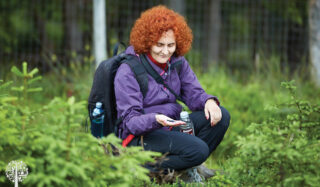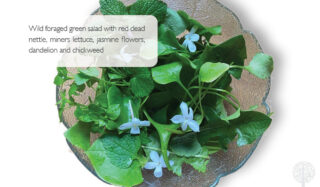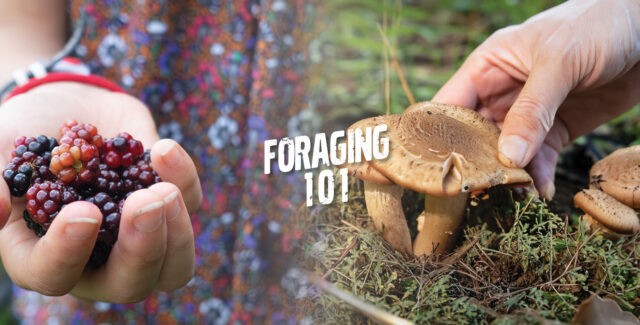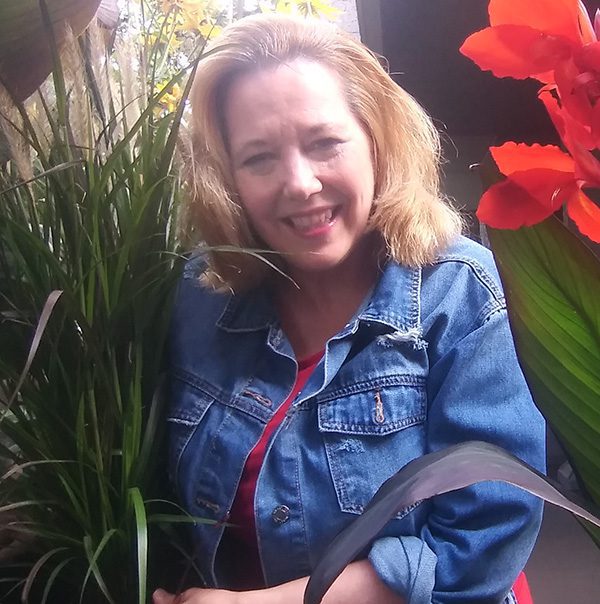
The Rise of Urban Foraging – The Invisible Harvest
Urban Foraging: The Rise of Foraging in Urban and Rural Landscapes
Every August, the crab apple trees on David Quinton’s residential street in Vancouver, Canada, are laden with fresh fruit. People come with ladders and long poles to reach the highest branches where the ripest apples hide. Others wait until they fall to the ground, then fill their buckets.
This is foraging. Different from a harvest of leafy greens, basil, or radishes garnered from a cultivated vegetable patch or community garden, foragers harvest food growing unhindered by human intervention in urban areas, suburban side streets, and along riverbanks, seashores, and remote forested regions. Throughout history, foraging has always been part of the human experience. However, the advent of industrialized agriculture and improved logistics in transporting goods changed the idea of going into the forest to look for wild asparagus. Why bother when we can find it with little to no effort at the grocery store? The price was worth the convenience until now.
The Guardian newspaper [1] reports that, in New Zealand, where inflation impacts food costs, increasing numbers of people are foraging to supplement the contents of their pantries. Nature’s bounty is offered at no charge but invisible to those who don’t know where to look or what foods are edible.
Learning About The Wild Side
The founder of Swallow Tail Canada [2], Robin Kort, is a trained chef and foraging enthusiast. She knows all the best places in British Columbia’s southern coastal rainforest to find wild edibles such as fiddlehead and licorice ferns, big-leaf maple flowers, and oyster mushrooms.
Kort says the pandemic caused people to think twice about traveling, and as a result, they have become more connected to their local environments. Her company offers online courses and foraging field trips throughout Metro Vancouver that educate participants on how to gather and prepare fresh kelp or trap a Dungeness crab without leaving the shore.
She says that people want to learn where to find local food and are excited about harvesting the green pinecones of British Columbia’s infamous Douglas Fir tree to make syrup.
The company’s website, swallowtail.ca, provides resources on what’s in season and is also clear that foraging is not about overindulgence. For example, if Kort is at the beach and only spots two pieces of kelp instead of ten, she won’t take any. She believes those two pieces are better served as part of the ecosystem than on her dinner plate.

Foraging Equals Sustainability
For Jonathan Forbes, foraging has always been about sustainability. His family lived in Toronto during the 1950s, and he remembers going out with his mother, a keen forager, to gather mushrooms, ginger, and leeks from the ravines, wetlands, and meadows across the region. Many of those areas have since been developed, and Toronto City Parks has a bylaw forbidding foraging to help preserve the area’s delicate biodiversity. The law also prevents the over-harvesting of the edibles found growing in the ravines denoted by the city as environmentally significant areas.
A keen environmentalist, Forbes believes that people will pay more attention to the natural world and learn how to care for it sustainably if they develop a relationship with it through food. So, in 1998, he started Forbes Wild Foods[4] to generate that awareness.
Expert foragers across Canada gather edibles for the company. Milkweed pods, cattail hearts, and even spruce tips are preserved and sold to restaurants, hotels, gift shops, food and health stores, and individuals. Only foods growing in natural abundance are harvested. The company prides itself in ensuring the foraging is done sustainably, encouraging harvesters to look at what they are taking as a pie. That means only cutting a slice of what is available each year so that nature can replenish the stock. The company also works to reintroduce wild foods to lands needing remedial attention, such as overgrazed woodlots and pastures. Adding native plants to a landscape helps repair the soil and enhance the ecosystem.

Fulfilling A Collective Need
In 2010 and 2011, Christchurch, New Zealand, experienced destructive earthquakes; large swaths of the city were demolished. The red zone, a ribbon of land stretching from the coastline to the inner city, was designated too unstable to rebuild, and 8,000 houses were destroyed[5]. However, vegetation, including fruit and nut-producing trees, remains in the area. Eleven years after the quakes, it has become a favorite spot for foraging, making a dramatic difference to Joanna Wildish’s household food costs. So she’s created Otautahi Urban Foraging[6], a shared resource for people in Christchurch to find plants, berries, and other supplies like firewood, pinecones, and seaweed.
Although wild foods have become trendy for restaurants that pay foragers to gather for them, Wildish says that practice is the opposite of what foraging is all about. She views foraging as a local community experience with a collective focus on sharing and maintaining nature’s abundance. She’d like to see foraging areas developed like food forests, as places people can go to supplement edible needs.
A Bountiful Harvest In More Ways Than One
Back in Vancouver, the crab apple harvest is in full swing. The normally quiet residential street is a hive of activity. A few years ago, the city came to chop the trees down, but after Quinton told them how people harvested the fruit, they went away and haven’t come back, he says. As a result, the ripe apples are everywhere, including on the ground and hanging from lower branches. What’s left after the human frenzy will be eaten by urban wildlife, like raccoons, skunks, and coyotes.
In New Zealand, Wildish says foraging is about leaving as much as possible, not only for other people but for animals, birds, bugs, and reseeding. I’m conscious of this as I fill my buckets with apples in Vancouver. I’ll share what I don’t use to make crab apple jelly with neighbors or take it to a community cupboard or fridge.

Summer in Canada is winter in New Zealand. As I harvest crab apples, Wildish is bundled up and is also out and about harvesting nutrient-rich purple nettle, dandelion, and onion weed. But it’s more than a free harvest of chickweed that makes foraging worthwhile. Being in nature, Wildish says, gives her a strong sense of inner resilience and belonging to the earth; this can serve as an inspiration to us all as we go about our harvests.
Sources:
- Foraging takes hold in New Zealand’s wild places | New Zealand | The Guardian (bit.ly/3A6ueds)
- About Us | Swallow Tail Canada (swallowtail.ca)
- Foraging prohibited by Toronto bylaw, city warns | CTV News (bit.ly/3y2m0jR)
- About – Forbes Wild Foods (wildfoods.ca)
- Residential red zone – Wikipedia (bit.ly/3bosAcH)
- Otautahi Urban Foraging | Facebook (facebook.com/Otautahi.Urban.Foraging)
Similar Articles
Tips For Safely Foraging Wild Foods
A desire for local, healthy food has sparked a newfound interest in foraging edible plants in the wild. This guide will help you safely plan your adventure!

Nutritious And Delicious Plants Ripe For Winter Foraging
The warmer seasons may be over, but winter can be a great time for foraging wild foods. Check out these top tips for finding great-tasting wild foods!

Self-Sustainability In The Wake Of A Pandemic
In the wake of the global pandemic, everyone suddenly wants to be more self-sustainable. Food security is a hot issue, and gardening is the activity of choice.

LEAVE A COMMENT

- Jennifer Cole
